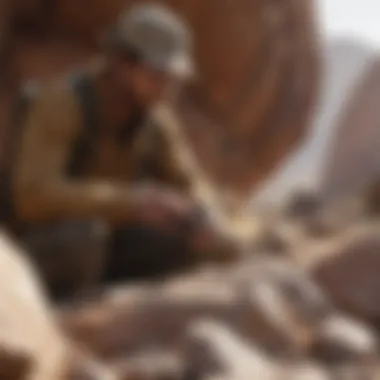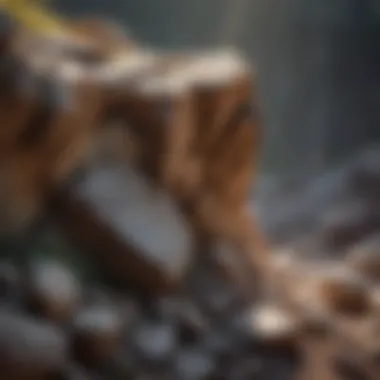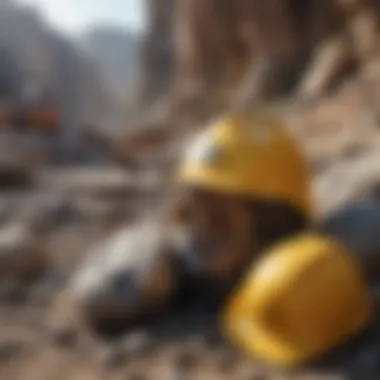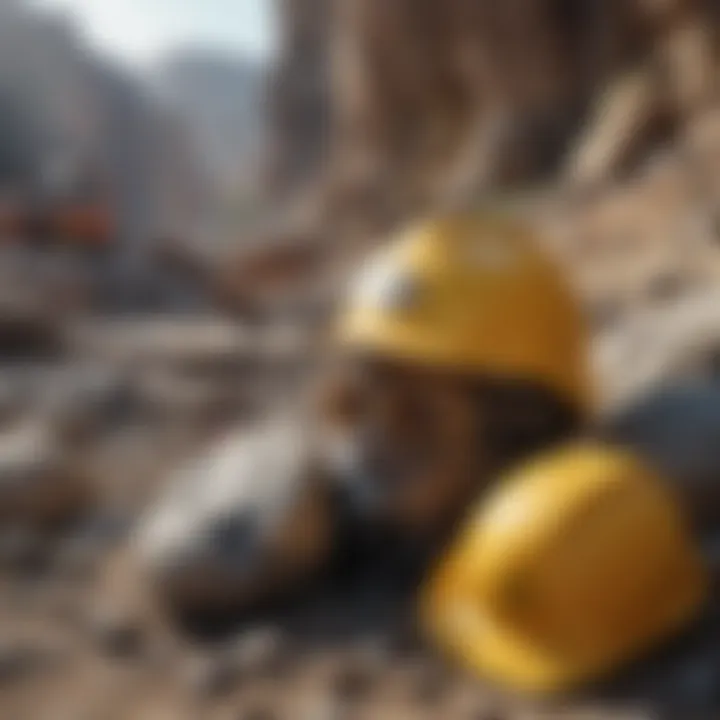Effective Methods and Tools for Breaking Rocks


Intro
In the world of geology, knowing how to effectively break rocks without damaging the piece itself or compromising personal safety is crucial. From the science that explains rock formation to the appropriate tools needed for breaking, each aspect plays a fundamental role in the collection process. By exploring both traditional and modern techniques, collectors can maximize their success while mitigating risks that come with the territory.
Featured Collectible of the Month
Overview
This month's highlighted collectible is the stunning Amethyst Geode, a rock that is sure to catch the eye of any collector. Characterized by its deep purple hues and unique crystal formations, Amethyst Geodes are not just aesthetically pleasing but are also sought after for their believed metaphysical properties.
Historical Significance
Historically, Amethyst has held high value; in ancient times, it was considered a stone of royalty. The Greeks cherished it, believing it held protective powers during events involving intoxication. This gem has helped shape the narrative of many civilizations. As a collectible, Amethyst Geodes encapsulate both beauty and a rich history worth exploring through careful extraction methods.
Identification Techniques
Visual Characteristics
Identifying rocks begins with keen observation. Take time in the field to inspect the texture, color, and layering of samples. Here are some notable features to look for:
- Color: Vivid coloration often indicates presence of specific minerals.
- Texture: Smooth or rough surfaces reveal its formation conditions.
- Layers: Distinct layers can provide insight into its geological history.
Resources for Identification
To expand your rock identification skills, several resources can be quite helpful:
- Books: Field guides on rocks and minerals are invaluable for collectors of all levels.
- Online Platforms: Websites like Wikipedia and Britannica can provide detailed insights.
- Community Forums: Engaging with other enthusiasts on platforms like Reddit or Facebook allows for shared knowledge and support.
"Understanding the characteristics of rocks can transform the way we approach collecting, turning a simple hobby into a captivating exploration of earth's stories."
The journey through the realm of rock collecting, supported by thorough techniques for breaking and identifying, fosters a deeper connection with our planet's geological narratives. Each step unveils the beauty hidden beneath layers of stone.
Understanding Rock Properties
Understanding rock properties is essential when it comes to breaking rocks effectively. This section provides insight into the foundational aspects that influence how rocks behave, especially in relation to breaking practices. By grasping the different compositions and physical characteristics of various rocks, collectors can select the most appropriate techniques and tools for their endeavors. This knowledge also helps in appreciating the geological formations that come from different rock types, which can add value to both the collection and the hobby.
Composition of Rocks
Minerals and Their Characteristics
The composition of rocks is primarily determined by the minerals present within them. Each mineral has unique characteristics, including hardness, crystal structure, and chemical stability. For instance, quartz is known for its toughness and resistance to weathering, making it a popular choice in many applications. Understanding these characteristics is useful because it allows collectors to predict how a rock might respond to different breaking methods.
One significant aspect of minerals is their hardness, as measured by the Mohs scale. The scale, ranging from talc (1) to diamond (10), helps assess which tools might be suitable for breaking various rocks. A rock rich in harder minerals, such as sapphire, will require more robust tools, whereas a softer rock with abundant clay minerals can be broken with more common hand tools. The unique feature of minerals greatly affects their breakability and, consequently, the processes involved in breaking rocks effectively.
Types of Rocks: Igneous, Sedimentary, and Metamorphic
The classification into three main rock types—igneous, sedimentary, and metamorphic—serves as a fundamental aspect of geology. Igneous rocks, formed from cooled magma or lava, tend to be quite hard, making them more challenging to break. Examples include granite and basalt. Sedimentary rocks, on the other hand, are composed of particles that have settled over time, such as sandstone and limestone. These are generally easier to break due to their layered structure, which can often flake away more readily.
Metamorphic rocks, formed under heat and pressure, display unique features such as foliation and banding. Their breakability can vary significantly based on their original mineral composition and the new minerals that formed during metamorphosis. Certain metamorphic rocks may appear tough on the surface but can break more easily along their foliation planes. Both the uniqueness of each type and their individual breakability are critical to collectors who need to navigate their tools and techniques accordingly.
Impact of Composition on Breakability
The mineral composition of a rock plays a pivotal role in determining how easily it can be broken. For example, a granite rock that is predominantly quartz will have a different breakability profile compared to one containing a higher concentration of feldspar. The arrangement and bonding of minerals within the rock also affect its durability. Rocks with a well-cemented structure may resist breaking compared to those that are loosely bound, which can crumble more easily under applied force.
Furthermore, the presence of certain minerals can act as a guide for collectors in choosing tools or methods. For instance, rocks with high calcite content could be effectively broken using acid, while those with stronger silicate minerals would require more mechanical strength. Thus, paying attention to rock composition does not just help in breaking them but also augments understanding of geological processes and increases awareness of tool selection and techniques associated with different rocks.
Physical Properties Affecting Breakage
Hardness and Toughness
Hardness refers to a rock's resistance to being scratched or indented, while toughness indicates how much force a rock can withstand before breaking. Both properties are crucial when selecting a breaking method. Highly tough materials can absorb energy without fracturing, such as basalt, while harder materials like quartz require sharper, stronger tools to break effectively. Collectors must understand these elements as they significantly impact the methodology of breaking rocks effectively.
Density and Porosity
Density is the measure of how much mass a rock contains in a given volume. High-density rocks, like granite, may be more challenging to break than less dense rocks, like pumice. Porosity, on the other hand, indicates the presence of pores or cracks within the rock, which can facilitate breakage when using specific techniques. Collectors can leverage knowledge of these properties to predict which rocks will yield more easily to their methods.
Grain Size and Structure
Grain size and the overall structure of a rock also stand at the forefront of how breakable a rock is. Coarse-grained rocks tend to hold their integrity better under force, while fine-grained structures might break apart more easily. Understanding grain configuration gives collectors insight into potential fracture points and assists in strategizing rock-breaking methods that factor in individual rock characteristics.
Traditional Rock Breaking Methods
Breaking rocks has been a fundamental practice throughout human history, serving not only practical purposes but also artistic and scientific endeavors. Traditionally, methods for breaking rocks have relied on simple but effective techniques that showcase our ingenuity and adaptability. Once you understand the various traditional methods available, you can choose the most suitable approach for your needs, whether it's for collecting, construction, or even artistic sculpting. With safety and efficiency in mind, a careful examination of these methods can be quite enlightening.
Manual Techniques
Working with your hands and basic tools might feel a bit old-fashioned, but when it comes to breaking rocks, there’s a certain charm and effectiveness that manual techniques bring.
Using a Hammer and Chisel


Using a hammer and chisel is one of the oldest methods known to humans for breaking rocks. This technique allows for targeted, precise strikes to weaken specific sections of rock, making it a great choice for both beginners and seasoned collectors alike. The beauty of this method lies in its simplicity—just a strong hammer and a well-designed chisel can do wonders.
Key characteristics of this method include:
- Precision: It enables you to focus on specific areas, useful when you’re after a particular shape or for exposing minerals.
- Control: You can determine the force applied, helping to minimize damage to the rock if you're looking to preserve it for collection.
However, patience is key here. It's often a slow process. Furthermore, this technique can be quite labor-intensive, contributing to fatigue.
Drilling and Splitting Methods
Drilling and splitting methods have made quite the name for themselves among rock breakers. Often used in mining as well as casual collecting, these methods involve drilling holes into the rock to insert splitting wedges. This technique capitalizes on the inherent weaknesses in the rock to create fractures effectively.
Some advantages of drilling and splitting include:
- Effectiveness: By creating pressure points in specific areas, you can break larger rocks with relative ease.
- Less Physical Labor: Compared to using a hammer directly, this method often requires less brute force, reducing physical wear and tear.
On the downside, you need specialized tools—drills and wedges—which not everyone may have access to, and setting it up takes time.
Hand Tools: Their Advantages and Limitations
Hand tools are the backbone of traditional rock breaking. They include a variety of equipment such as picks, hammers, chisels, and pry bars. Each serves its unique purpose in rock breaking, offering various advantages and disadvantages.
The appealing part is their versatility; many hand tools are easily accessible and offer great control over the process. They are often preferred by hobbyists who enjoy the tactile experience of breaking rocks. Here are some highlights:
- Advantages:
- Limitations:
- Cost-effective and widely available.
- Easy to handle and require no electricity.
- Allow for creativity in breaking shapes and sizes.
- Physical toll if used constantly.
- Harder to break extremely tough materials compared to power tools.
Fire and Water Applications
As you venture into methods beyond manual labor, fire and water applications come to play. These techniques harness natural elements, showcasing a unique approach compared to conventional methods.
Thermal Expansion Techniques
Thermal expansion techniques involve heating rocks to cause them to crack under pressure. This is done by applying intense heat to targeted areas. On the surface it might seem like magic, there’s a scientific basis behind this magic! As rocks heat up, they expand and when they cool, they contract—which can lead to fractures.
Key characteristics here involve:
- Speed: This method can break larger pieces in shorter periods.
- Unique Applications: Great for situations where manual techniques don’t work, particularly in more robust materials.
However, safety concerns arise; handling heat sources can be very dangerous. Fire can easily get out of control, and proper precautions must be taken.
Hydraulic Power in Breaking Rocks
Hydraulic power is another interesting method, especially favored in serious construction or quarrying. This method uses the force generated by hydraulic fluids to exert pressure on rocks, effectively splitting them. The beauty of hydraulic power lies in its efficacy — large masses of rock can be handled without excessive physical labor.
Highlights include:
- Powerful: It’s capable of breaking incredibly tough rocks.
- Less Effort: Operators can manage larger tasks without considerable physical strain.
The downside? It requires significant investment in equipment and access to hydraulic systems, which may not be feasible for casual collectors.
Environmental Concerns with These Methods
It's crucial to be mindful of environmental impacts when employing rock breaking methods. Traditional methods can sometimes disturb local ecosystems, create dust, or contribute to noise pollution. Understanding the ramifications of using fire or hydraulic applications, in particular, is vital in today’s environmentally aware society.
Considerations include:
- Soil Disturbance: Activation of dormant insects or animals within the soil, potentially disrupting the local habitat.
- Waste Generation: Unwanted debris leading to the accumulation of industrial waste around the breaking site.
Both environmental impact and respect for nature play a key role when opting for any rock breaking method.
Modern Technology in Rock Breaking
The integration of modern technology into rock breaking has reshaped the landscape of geology and mineral collection. By utilizing advanced tools and techniques, collectors and professionals are able to enhance their efficiency and precision when handling robust geological materials. This section will dive into some of the cutting-edge advancements that have made their mark in this field.
Power Tools and Machinery
Jackhammers and Their Use Cases
Jackhammers are indispensable in the modern rock-breaking arsenal. Their design is centered on delivering rapid, forceful impacts to fragment tough materials. One of the primary advantages of a jackhammer is its ability to penetrate deeply into hard surfaces, making it a favorable choice for breaking rocks in construction and quarrying sites. The key characteristic that stands out is its pneumatic or electric-powered mechanisms giving it consistent performance.
Nonetheless, using a jackhammer comes with its own set of challenges. Operators must ensure proper training and familiarity with tool handling, as misuse can lead to serious injuries. Additionally, they can create a significant noise level, which raises concerns about hearing protection during prolonged use.
Diamond Saws: Precision Cutting
Diamond saws symbolize the pinnacle of precision in cutting through stones. The blades are embedded with diamond particles, allowing for clean, fine cuts without fracturing the stone. This is particularly beneficial when dealing with delicate or rare specimen finds in geological explorations. The smoothness of the cut, resulting from this technology, enhances the overall aesthetics of collected rocks.


However, the diamond saw’s limitations lie in its cost. These machines often require substantial investment, which might not be justified for casual collectors. Moreover, the blades can wear down quickly, necessitating timely maintenance and replacement, adding an element of ongoing expense.
Robotic Technologies in Geology
Robotic technologies are making waves in various fields, and geology is no exception. Robots equipped with specialized tools can navigate challenging terrains and reach inaccessible spots where a human might struggle. They’re especially vital in geological surveys and research, offering precise data and minimizing the risks posed to human operators.
The standout feature of robotic technology is its ability to operate autonomously, gathering information efficiently without the need for constant supervision. That being said, they’re not without disadvantages. Limited battery life and the potential for mechanical failures can disrupt their functionality, and operating these sophisticated machines often requires a steep learning curve.
Chemical Agents for Rock Breaking
Expansive Agents and Their Mechanisms
Expansive agents are an innovative solution for breaking rocks without the typical noise and dust associated with machinery. These agents, when mixed with water and placed in drilled holes, expand remarkably, creating pressure that fractures the rock. The key advantage is their ability to minimize environmental disruption, making them an appealing option for collectors who prioritize ecological sensitivity.
However, one must handle these agents with care. The process can take time, and improper usage can lead to unpredictable results. Moreover, sourcing high-quality expansive agents can occasionally be a challenge.
Sulfuric Acid and Other Corrosive Agents
Sulfuric acid offers a different approach to rock breaking, acting as a potent agent for dissolving minerals. This technique is valuable for collectors aiming to extract specific minerals from rock formations. The strength of sulfuric acid lies in its rapid action, significantly accelerating the breaking process compared to mechanical means.
Despite its advantages, safety cannot be overlooked. Handling sulfuric acid demands strict adherence to safety protocols to avoid severe skin or eye damage. Additionally, the environmental impact of such chemicals raises valid concerns for responsible collectors.
Environmental Impact of Chemical Usage
Using chemical agents in rock breaking invites an important discussion on environmental repercussions. The environmental footprint of certain chemicals can be alarming, particularly when considering the potential contamination of soil and water sources. Recognizing the balance between effective rock breaking methods and ecological well-being is essential.
They can certainly be effective and beneficial methods, but one must carefully evaluate the long-term impacts. Sustainable practices and alternative, benign agents must be considered in any comprehensive rock breaking strategy.
In the quest for effective rock breaking techniques, modern technology offers numerous tools and methods, each with its unique pros and cons. When selecting the right method, one must weigh the efficiency against safety and environmental considerations.
Embracing technology not only enhances our capabilities but also challenges us to remain mindful of our responsibility as stewards of the environment.
Safety Considerations
In the pursuit of effectively breaking rocks, overlooking safety can lead to unintended accidents and injuries. Prioritizing safety measures not only protects the individual collector or enthusiast but also enhances the overall experience in the field. By adhering to safety guidelines, one can navigate the potentially hazardous environments and equipment associated with rock breaking, ensuring a smoother, more enjoyable process. Below, we delve into key elements surrounding this vital topic.
Protective Gear Essentials
Eye and Face Protection
Eye and face protection stands as one of the most crucial components in any rock breaking endeavor. With flying debris and dust being a common occurrence, the risk of eye injuries cannot be overstated. Using safety goggles or face shields creates a barrier against these hazards, ensuring that your vision remains unaffected.
The key characteristic of eye protection is its robust design, which can withstand impacts and shield against potentially harmful particles. Many professionals favor polycarbonate lenses for their lightweight and durable nature, offering comfort without sacrificing safety. The unique feature of these protective items is their ability to filter out UV rays, an added benefit when working outdoors. On the downside, they can fog up in humid conditions, which may impede visibility unless they are specifically designed to address this.
Clothing and Footwear Choices
Selecting appropriate clothing and footwear is equally paramount. Sturdy clothes that can withstand abrasions protect against cuts and scrapes that might occur when handling rough or heavy materials. Durable fabrics, like denim or canvas, provide this protection effectively.
Another key characteristic is the choice of footwear. Heavy-duty boots with steel toe protection should be worn, especially when large rock fragments are involved. These boots not only protect ankles but also provide grip on uneven surfaces. Their unique feature is the slip-resistant soles designed for rocky terrains, minimizing the risk of accidents. However, it’s essential to get the right fit; poorly fitted shoes can cause discomfort over time, detracting from the overall experience.
Hearing Protection in Loud Environments
In environments where machinery like jackhammers are used, hearing protection becomes an indispensable tool. Prolonged exposure to loud sounds can lead to hearing loss, making earplugs or noise-cancelling earmuffs essential.
A key characteristic of effective hearing protection is its ability to reduce noise to safe levels while allowing for communication. Specifically, earmuffs offer a snug fit that envelops the ears, providing superior sound dampening. The unique feature of these devices is the integration of communication systems in some models, facilitating clear dialogue in noisy work sites. However, wearing earmuffs may sometimes isolate users from their surroundings, which could be a drawback if awareness of the environment is vital.
Minimizing Risks During Rock Breaking
Understanding Your Environment
Understanding the environment in which you’re working is crucial to staying safe. Locations vary in their risks, from loose rock formations to varying weather conditions. Recognizing these aspects can directly influence safety practices.
The key characteristic of correctly assessing your surroundings is awareness; knowing factors like terrain stability and weather patterns aids in planning activities that lessen risks. This understanding becomes a beneficial approach, especially when working in remote areas where assistance might be far away. On the flip side, spending excess time surveying could delay work, but it is a trade-off worth considering for safety.
Proper Tool Handling Techniques
Proper tool handling techniques are a cornerstone for safety when breaking rocks. Familiarizing oneself with the equipment and its appropriate use minimizes risks of injury. This includes knowing how to handle hammers, chisels, and other breaking tools without compromising safety.
A key characteristic of this approach is training; how one wields tools can drastically affect the outcome, both in terms of efficiency and risk. Using techniques such as maintaining a firm grip while keeping hands clear of striking zones exemplifies safety in action. One disadvantage, however, is that improper techniques can sometimes be difficult to unlearn once formed.
First-Aid Measures for Common Injuries
Despite all precautions, accidents can happen, making it imperative to be prepared with first-aid measures for common injuries. Scrapes, cuts, and strains are common when engaging with rock breaking activities.
The key characteristic of having a first-aid kit readily available is to ensure immediate care is accessible. Including items like antiseptic wipes, bandages, and gauze allows for quick responses to minor injuries, substantially reducing the risk of infection. An added benefit is the reassurance of preparedness, allowing enthusiasts to focus on their activity with peace of mind. However, if one lacks the knowledge of how to use these items effectively, their benefits may fall short.
Always remember, preparation is the first step to a safe and enjoyable rock breaking experience.
Best Practices for Collectors


Collecting rocks is not just about gathering beautiful specimens; it’s a nuanced practice that requires informed decisions and ethical considerations. Employing best practices enhances your experience while helping sustain the environment. As a collector, knowing the ropes can elevate your hobby to new heights, ensuring that you respect both the resources you cherish and the landscapes you explore.
Identifying Collectible Rocks
Researching Specific Geological Areas
When venturing into a new geological area, it's crucial to do your homework. Researching specific geological areas means understanding local rock formations, which can lead to incredible finds. Each location is like a treasure chest, hiding unique specimens waiting to be uncovered. Knowing the geological history of an area informs you of which rocks might be collectible.
One key characteristic of researching these areas is the ability to spot patterns in rock types. For example, areas rich in sedimentary layers often yield fossils, while igneous terrains may present stunning gemstones.
While this targeted approach can certainly increase the odds of finding interesting rocks, it does take time and effort. However, the rewards usually outweigh the penalties. Leveraging local geological surveys or visiting geological clubs can provide insights into the specific characteristics of sites, offering collectors an edge in their pursuits.
Spotting the Characteristics of Rare Finds
Identifying what makes a rock rare is essential to a successful collection. Spotting the characteristics of rare finds often involves a keen eye for detail. Look for unusual colors, patterns, or formations that aren’t commonly found. For example, a rock with an iridescent surface might indicate certain minerals that suggest uniqueness.
The most compelling trait of rare finds is their ability to fascinate both the collector and the public. These pieces not only enhance personal collections but can also transform into conversation starters across various settings.
The challenge, however, lies in differentiating between specimens that are simply aesthetically pleasing and those that are truly valuable. Education and experience play a huge role in making this distinction.
Using Technology for Identification
Tech tools have made it easier to identify collectible rocks in today’s world. Using technology for identification leverages apps and online resources that allow you to categorize and understand the rock compositions visually and chemically. These software tools can help analyze rock structures or even link to online databases to verify species.
One notable characteristic of tech-based identification is the immediacy it offers. With just a smartphone, you can capture the essence of a rock and get almost instant feedback on its identity.
Yet, relying solely on technology has its drawbacks. It's important to remember that some tools may not be fully accurate, and human understanding remains indispensible. Supplementing tech use with traditional knowledge enhances its effectiveness.
Responsible Collecting Techniques
Legal Aspects of Rock Breaking
To preserve natural resources and cultural heritage, understanding the legal aspects of rock breaking is paramount. Legal regulations vary widely by region and can involve permissions required for digging or collecting rocks. Familiarity with these laws helps prevent unintentional violations that can lead to consequences.
One key aspect is recognizing that certain areas may be classified as protected lands, where removal of rocks is illegal. As a responsible collector, it’s essential to familiarize yourself with these stipulations. Knowing the acceptable collecting guidelines enables you to enjoy your hobby without legal repercussions.
A unique feature of understanding legal requirements is that it not only safeguards the collector but also contributes to conservation efforts. Being informed fosters responsible citizenship within the geological community.
Maintaining Ecological Balance
Collecting rocks should also come with a sense of ecological responsibility. Maintaining ecological balance means recognizing that rock formations are part of an intricate ecosystem. When collectors disturb these areas, they risk disrupting habitats that animals and plants depend on.
One essential characteristic of respectful collecting is practicing minimal impact techniques. This includes gathering stones in small quantities, avoiding areas with high ecological sensitivity, and always leaving a location as you found it.
The unique feature here is that practicing responsible collecting not only benefits the environment but also enhances personal fulfillment. Collectors can take pride in knowing they are protecting the landscapes they love.
Ethical Considerations in Rock Collection
Lastly, ethical considerations in rock collection cannot be overlooked. These involve questions of fairness and respecting the origins of your finds. For example, stones belonging to Indigenous communities might have cultural significance, and collecting those without permission could be considered disrespectful.
A key aspect here is understanding that each rock has a story, and many have historical or cultural importance. Ethical collecting promotes an important dialogue about respecting the geology and culture.
Additionally, being respectful of the areas you collect from leads to better relationships between collectors and local communities. This alignment fosters goodwill and opens the door for shared knowledge about geology, which can be invaluable to collectors.
"Knowledge without respect is merely ignorance masquerading as wisdom."
Collecting rocks is an intricate dance that requires knowledge, ethics, and an appreciation for nature. Mastering these best practices elevates your collection into a conversation with the earth itself, enriching both your experience and that of generations to come.
Epilogue
The discussion surrounding rock breaking techniques is not merely an academic exercise but a crucial element for practitioners and enthusiasts alike. As we’ve explored throughout this article, understanding the intricate methods employed to break rocks can significantly enhance both the toolkit and expertise of collectors.
Reflecting on Rock Breaking Techniques
Examining rock breaking techniques gives insight into how practices have evolved and adapted over time. Collectors must appreciate both longstanding traditions and innovations that offer greater efficiency or safety.
Combining Tradition with Modern Techniques
Combining traditional methods with modern advancements is a theme that resonates deeply in rock breaking. Traditional techniques, such as the use of hammers and chisels, have stood the test of time due to their reliability and simplicity. In contrast, modern machinery like hydraulic chisels brings power and precision to the table. This blend ultimately serves well for collectors, allowing them to navigate both small and large projects effectively.
The key characteristic of this synergy lies in its versatility — older methods provide a hands-on feel, while newer technologies offer efficiency. Adapting this blend enhances the collector's experience, ensuring they can undertake a broader range of tasks without compromising results.
The Future of Rock Breaking Methods
Looking ahead, the future of rock breaking methods seems bound to technological evolution. Innovations like drones for aerial survey or augmented reality tools for geological mapping are emerging. These advancements promise to revolutionize how enthusiasts approach rock breaking, making it more methodical and less perilous.
The unique feature of these upcoming technologies is their capacity to reduce physical strain while increasing precision. However, there lies a potential downside: the increased reliance on machinery could detract from the tactile learning experience many voracious collectors cherish. Balancing technology with experience will be key as techniques continue to evolve.
Encouraging Responsible Collecting
Encouraging responsible collecting is paramount for sustaining the natural environments that rock collectors explore. This principle underscores the need to weigh the implications of our actions on ecological systems. Understanding local laws and respecting sites fosters ethical practices among collectors, ensuring that geological treasures are preserved for future generations.
The key characteristic of promoting responsible collecting is education. By equipping collectors with awareness about legal and ethical considerations, we enable them to make informed decisions that align with environmental stewardship. However, the challenge remains in ensuring that both novice and experienced collectors adhere to these principles consistently.
"Collecting rocks is more than a hobby; it is a bond between nature and collector, one that calls for respect and diligence."
In closing, the integration of traditional methods with modern techniques, coupled with a commitment to responsible practices, illustrates the multifaceted nature of rock breaking. As collectors navigate both time-honored traditions and contemporary advancements, they enhance their role in geology while safeguarding it for future enthusiasts.



